Ticket to the world of USB 3.0, inexpensive
Despite the fact that all kinds of network services have almost completely replaced portable hard drives, sometimes you want to take and “save” all the most important things so that it lies somewhere close by. Or download a movie car from the tracker and connect the disk to the media player, so that you can watch the video for a month without getting up from the couch. Well, or ... what am I telling you - you already know everything yourself. So I had a need for an external drive with a USB 3.0 interface - under a cat I share my impressions of one of the devices.

Complete with a hard drive (the name of which, according to the documents, Kingmax KE-71 ) was only a paper instruction, a connecting Y-shaped wire and a rather rough case with a slant “under the skin”.
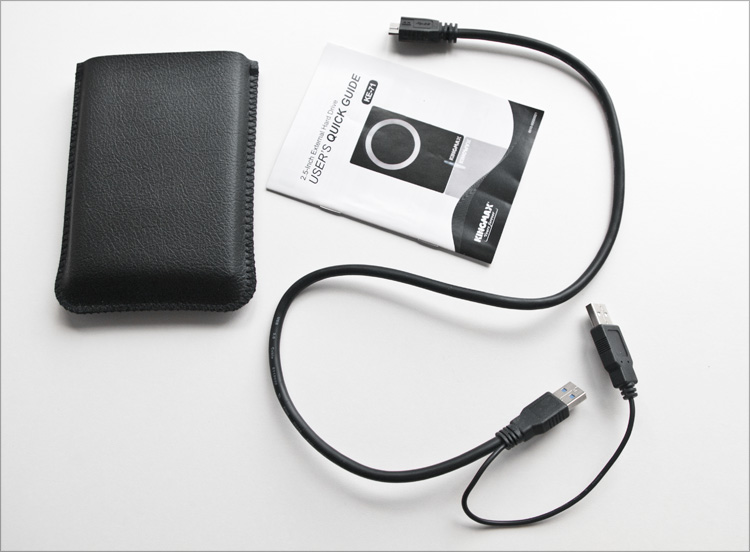
But on the other hand, it is needed only to preserve the original appearance of the device, so what's the difference what kind of cover is there - it's good that it even exists. And the main thing in the hard drive is speed.
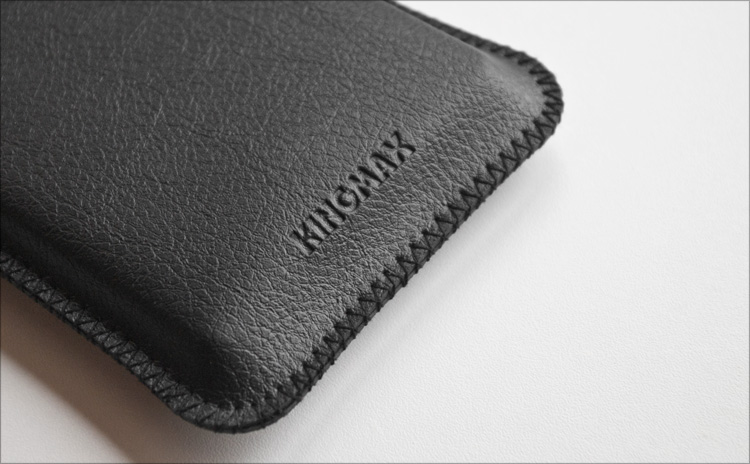
The appearance of the drive is quite common for this class of devices - there is no "highlight" in it. If you do not take the decor on the top cover for it, such a silver ring on top of black plastic. Why it is and why it is so is incomprehensible; Apparently, the find of the designer.
The size of the device dictates the hard drive installed inside - it is a little more than a pack of harmful cigarettes.
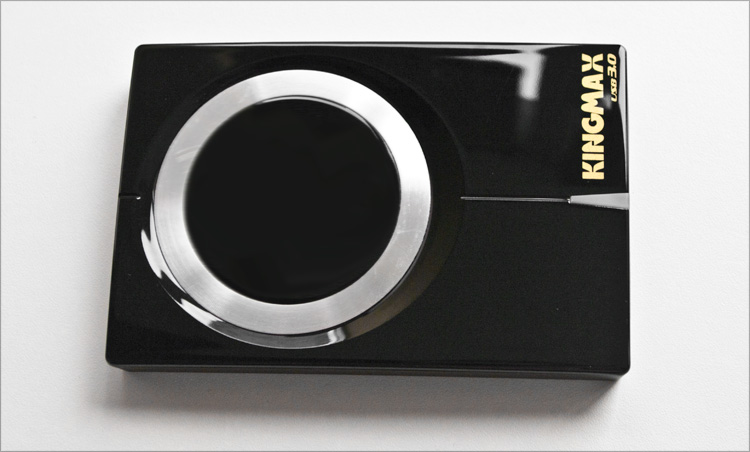
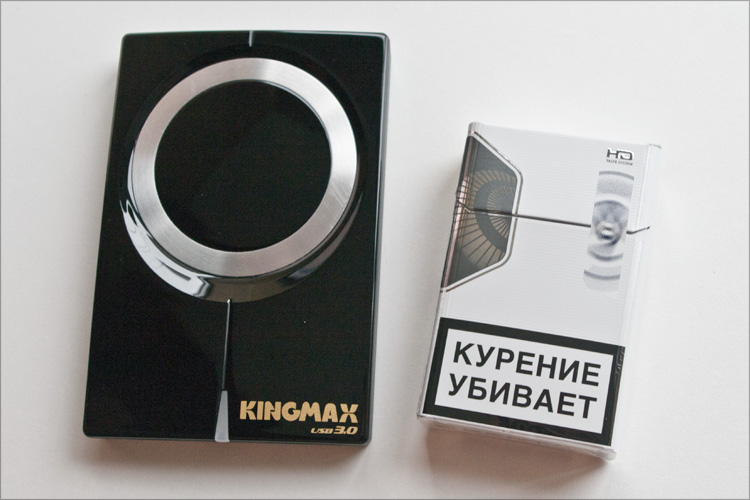
Next to the ring is a matte LED that displays the status of the device (during operation, it is dull blue). Near it is the only USB connector:
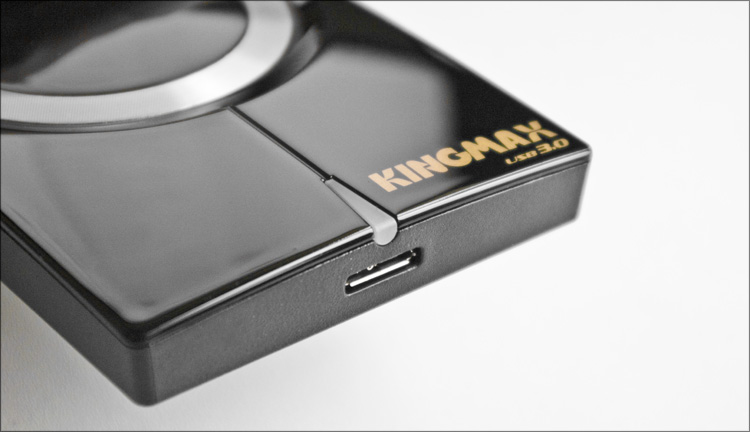
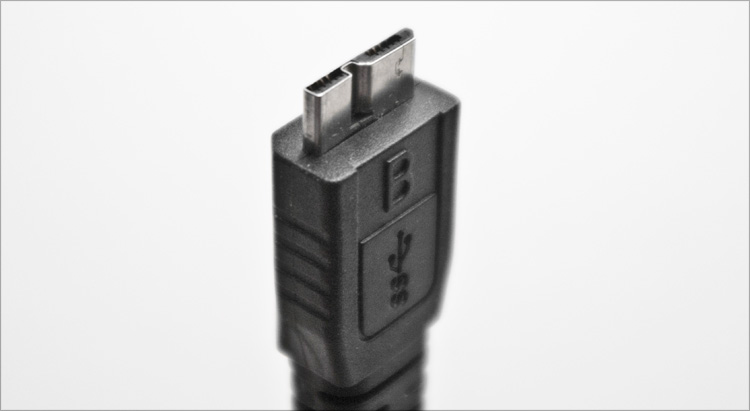
Immediately after the connection, the disk becomes visible in the system - the user has 465 gigabytes with the NTFS file system:

I took performance indicators from the recently updated HD Tune Pro 5.0 utility :

Read:

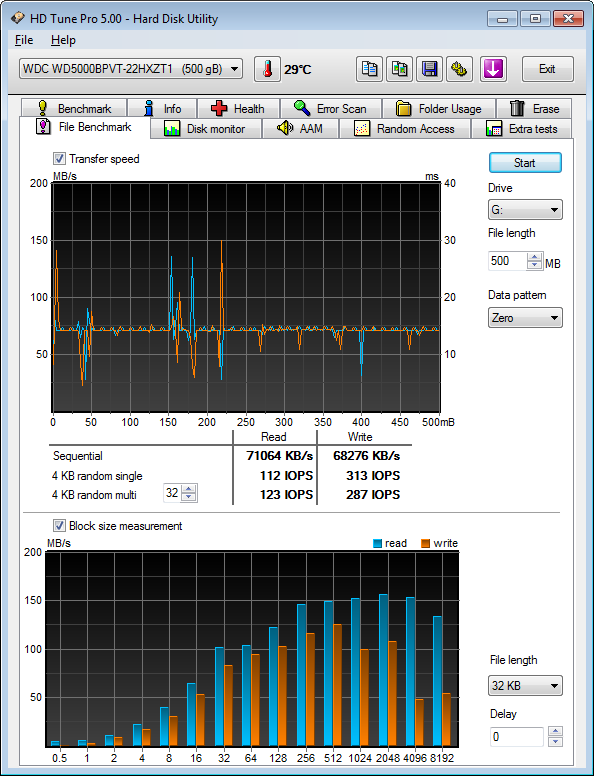
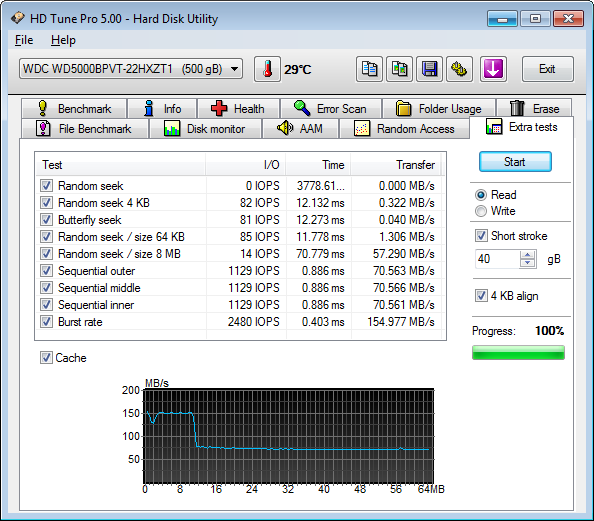
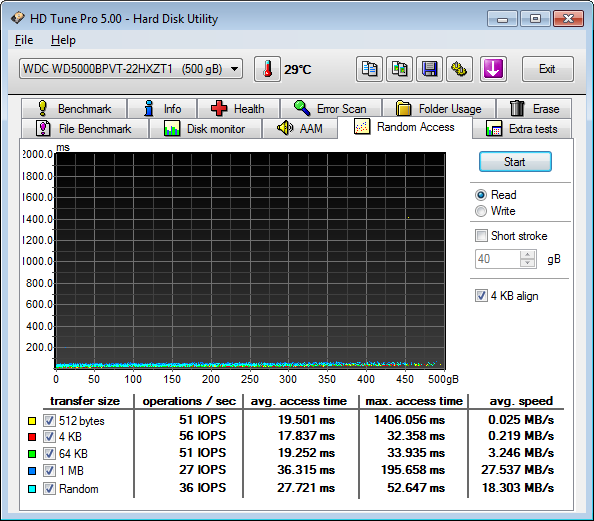
I had to delete the partition from the device to test the write speed:
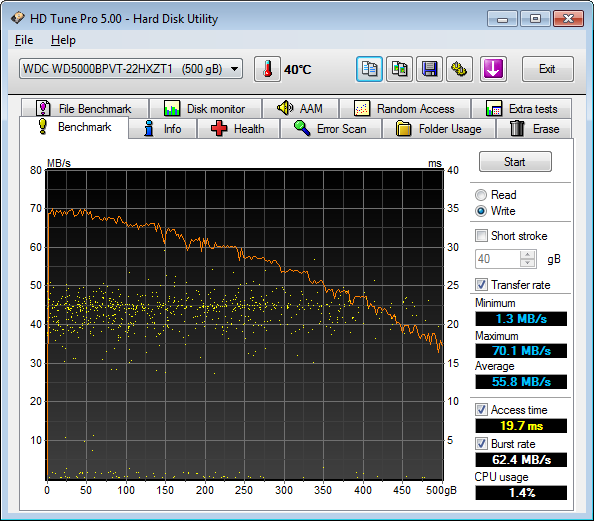
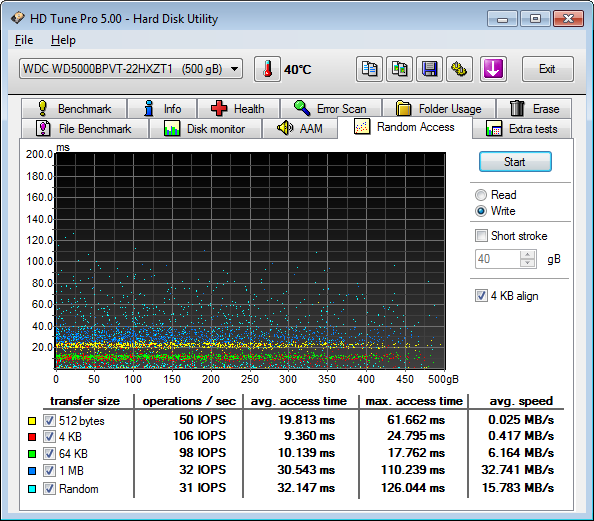
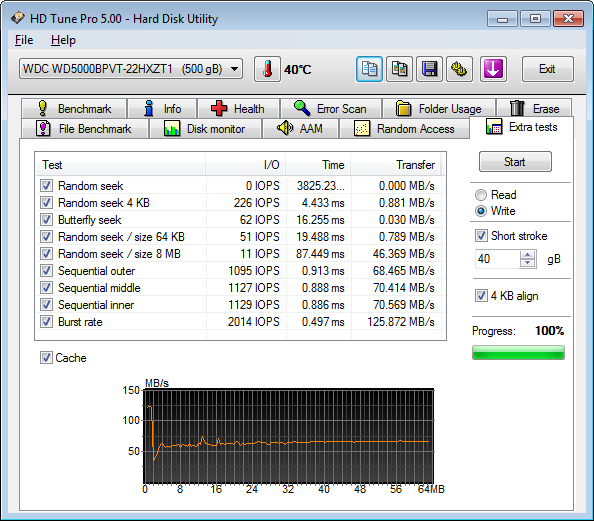
It's not that I'm very surprised results, but they are pretty good for a USB connection - I’ve already managed to evaluate the difference in speed when transferring data (compared to the old USB 2.0 drive) from a work laptop to a home computer.
After all the tests, the disk warmed up to 40 degrees.
It was interesting to get inside the drive - evaluate the design of the box, take a look at the device board, and admire the drive itself. The top cover (the one with the ring) is literally separated with a fingernail (or a flat screwdriver), but, apparently, only once.

The fact is that around the perimeter of the lid there are thin plastic loops that break after the first dismantling - I swear, I didn’t want evil =) But now I understand why the case comes with the kit - the device does not now delaminate only because it is glued I did not cover.
Inside is the most common 2.5-inch drive from Western Digital (500GB Scorpio Blue - WD5000BPVT) having a spindle speed of 5400 revolutions. No anti-vibration pads, but even without them, the drive is quite quiet.
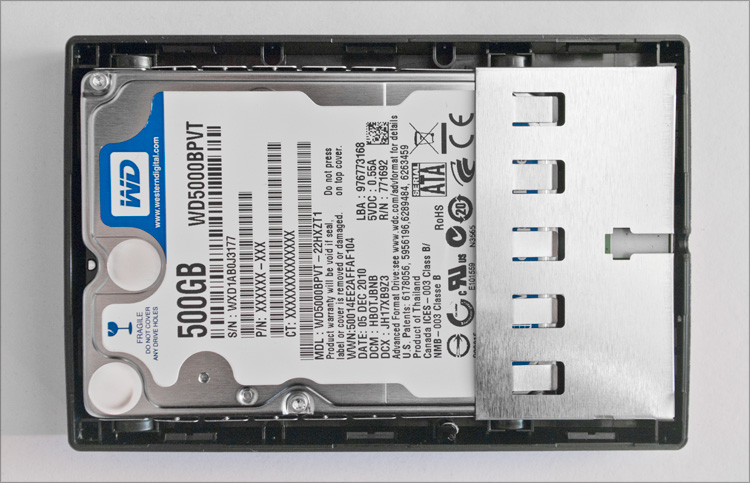
The speed performance of this drive from WD with a normal connection is higher ( read / write ), and considering that it is still far from the scope of USB 3.0 capabilities, I conclude that the speed “cuts” between the drive and the USB connector. Actually, this little handkerchief (which I don’t have much to tell about) reveals “all” of the delights of the USB 3.0 interface:

That's all - I won’t highlight any pros and cons separately. This post is just an illustration of what modern discs are like - now you have something to compare with.
I forgot to say that the cost of the device a week before the publication of the article was 2200 rubles, which is one and a half thousand less than the current cost of the disk installed inside. Unfortunately, now the disk has disappeared from the shelves of Yandex.Market, but if desired, it can always be found on sale by the model name.
If you are looking for an external drive for a modern interface - the option from the review is quite suitable as a solution, otherwise it is nothing more than a primitive box for a regular hard drive.

Complete with a hard drive (the name of which, according to the documents, Kingmax KE-71 ) was only a paper instruction, a connecting Y-shaped wire and a rather rough case with a slant “under the skin”.

But on the other hand, it is needed only to preserve the original appearance of the device, so what's the difference what kind of cover is there - it's good that it even exists. And the main thing in the hard drive is speed.

The appearance of the drive is quite common for this class of devices - there is no "highlight" in it. If you do not take the decor on the top cover for it, such a silver ring on top of black plastic. Why it is and why it is so is incomprehensible; Apparently, the find of the designer.
The size of the device dictates the hard drive installed inside - it is a little more than a pack of harmful cigarettes.


Next to the ring is a matte LED that displays the status of the device (during operation, it is dull blue). Near it is the only USB connector:


Immediately after the connection, the disk becomes visible in the system - the user has 465 gigabytes with the NTFS file system:

I took performance indicators from the recently updated HD Tune Pro 5.0 utility :

Read:




I had to delete the partition from the device to test the write speed:



It's not that I'm very surprised results, but they are pretty good for a USB connection - I’ve already managed to evaluate the difference in speed when transferring data (compared to the old USB 2.0 drive) from a work laptop to a home computer.
After all the tests, the disk warmed up to 40 degrees.
It was interesting to get inside the drive - evaluate the design of the box, take a look at the device board, and admire the drive itself. The top cover (the one with the ring) is literally separated with a fingernail (or a flat screwdriver), but, apparently, only once.

The fact is that around the perimeter of the lid there are thin plastic loops that break after the first dismantling - I swear, I didn’t want evil =) But now I understand why the case comes with the kit - the device does not now delaminate only because it is glued I did not cover.
Inside is the most common 2.5-inch drive from Western Digital (500GB Scorpio Blue - WD5000BPVT) having a spindle speed of 5400 revolutions. No anti-vibration pads, but even without them, the drive is quite quiet.

The speed performance of this drive from WD with a normal connection is higher ( read / write ), and considering that it is still far from the scope of USB 3.0 capabilities, I conclude that the speed “cuts” between the drive and the USB connector. Actually, this little handkerchief (which I don’t have much to tell about) reveals “all” of the delights of the USB 3.0 interface:

That's all - I won’t highlight any pros and cons separately. This post is just an illustration of what modern discs are like - now you have something to compare with.
I forgot to say that the cost of the device a week before the publication of the article was 2200 rubles, which is one and a half thousand less than the current cost of the disk installed inside. Unfortunately, now the disk has disappeared from the shelves of Yandex.Market, but if desired, it can always be found on sale by the model name.
Conclusion
If you are looking for an external drive for a modern interface - the option from the review is quite suitable as a solution, otherwise it is nothing more than a primitive box for a regular hard drive.
